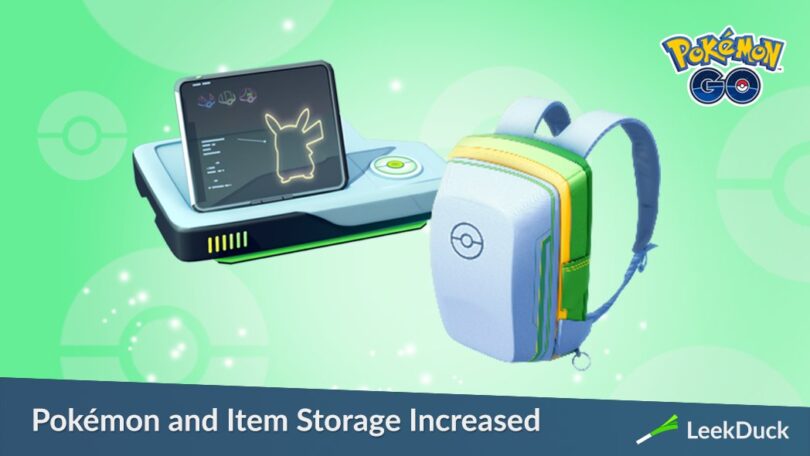How to Manage Your Pokémon Storage Like a Pro
Pokémon games have evolved over the years Pokémon Storage, offering players expansive worlds, countless Pokémon species, and complex strategies. While catching Pokémon is exciting, managing your Pokémon storage can become a daunting task, especially as your collection grows. If you’re tired of scrolling endlessly through boxes or losing track of your favorite Pokémon, mastering storage management is essential. This guide will walk you through strategies, tips, and expert practices to keep your Pokémon storage organized and optimized, helping you become a pro in no time.
Understanding Pokémon Storage
Before diving into management strategies, it’s important to understand how Pokémon storage works. In most Pokémon games, your Pokémon are stored in boxes, separate from your party. The number of Pokémon you can carry directly depends on the game you’re playing. Storage systems may vary slightly between titles, but the concept remains similar: a way to keep Pokémon accessible, sorted, and ready for use.
Storage Limits
Most games allow a certain number of Pokémon in your party (typically six) and hundreds more in storage boxes. As you progress, you can often expand your storage, either through in-game upgrades or digital expansions. However, without proper organization, a large storage can quickly become cluttered, making it difficult to find the Pokémon you need.
Why Proper Storage Matters
Proper storage isn’t just about convenience; it’s a strategic tool. Having organized Pokémon allows you to:
-
Quickly assemble teams for battles.
-
Access Pokémon for trades and events.
-
Easily manage breeding and training efforts.
-
Maintain a catalog of rare or favorite Pokémon.
Categorizing Your Pokémon
The first step in professional storage management is deciding how to categorize your Pokémon. Categorization allows you to locate Pokémon quickly and ensures you’re using storage efficiently.
By Type
Organizing Pokémon by type is one of the most popular methods. For example, having all Fire-type Pokémon in one box makes it easy to assemble type-specific teams or counter certain opponents. You can also combine similar types in multi-type boxes for flexibility.
By Rarity
Rare Pokémon, such as legendaries, shiny variants, or event Pokémon, deserve their own box. Keeping them separate prevents accidental trades or transfers and allows you to showcase your most prized catches.
By Role in Battle
Another effective strategy is sorting by battle roles, such as attackers, defenders, support, or utility Pokémon. This method is particularly helpful for competitive players who frequently build different battle teams.
By Generation
For collectors, organizing Pokémon by generation can be satisfying and practical. It allows you to track which Pokémon belong to which regions and ensures your collection is comprehensive.
Hybrid Organization
Pro players often combine methods. For instance, one box could contain rare attackers, while another contains utility Pokémon sorted by type. Experiment with what feels intuitive to you.
Naming Conventions
Names can play a critical role in storage management. A systematic naming convention helps you identify Pokémon at a glance, particularly if you have duplicates or similar-looking species.
Include Key Stats
Some trainers include IV (Individual Value) information or key stats in Pokémon names. For example, “Charizard 31/31/31” immediately tells you it has perfect IVs in certain stats.
Use Abbreviations
Using short abbreviations for type, ability, or role keeps names manageable and readable. For example, “BTK Garchomp” could mean “Battle Tank Garchomp.”
Highlight Shiny or Event Pokémon
Adding “SH” for shiny or “EV” for event Pokémon in the name makes them instantly recognizable, reducing the risk of accidental trades or transfers.
Read More: Pokémon Go Friendships: How to Level Up Faster
Sorting Tools and Features
Most modern Pokémon games include features to aid storage management. Knowing how to use them effectively can save hours of frustration.
Search Functions
Search tools allow you to find Pokémon by name, type, level, or other criteria. Using search filters is essential when you have hundreds of Pokémon.
Sorting Options
Sorting by level, type, recent addition, or battle readiness helps you quickly locate the Pokémon you need for training or battles.
Box Expansion
Invest in storage expansion whenever possible. More boxes mean more flexibility in organization and less overcrowding, which makes retrieval faster.
Prioritizing Your Pokémon
Not all Pokémon need the same attention. Prioritizing which Pokémon to keep in your party or boxes helps maintain an efficient system.
Keep Active Pokémon Separate
Your frequently used Pokémon, such as your main battle team or breeding candidates, should be in easily accessible boxes. This reduces time spent searching during gameplay.
Store Event and Legendary Pokémon Safely
Legendaries and event Pokémon are often irreplaceable. Keep them in dedicated boxes and avoid using them for training or battles unless necessary.
Manage Duplicates
Having multiple Pokémon of the same species can be useful, especially for competitive battles or breeding. However, excessive duplicates can clutter your boxes. Decide which duplicates are necessary and which can be released or traded.
Optimizing Breeding and Training
Pokémon storage isn’t just about keeping Pokémon; it’s also crucial for breeding and training.
Breeding Boxes
Set aside boxes specifically for breeding. Organize them by parent Pokémon, egg-ready Pokémon, and hatched offspring. This prevents confusion and ensures efficient breeding cycles.
Training and EV Management
Competitive players often focus on EV (Effort Value) training. Keeping boxes organized by training status (untrained, partially trained, fully trained) allows you to streamline the EV training process.
Use Pokémon Storage for Strategy
Some players store Pokémon that counter popular meta-game threats. Having these ready in dedicated boxes allows you to swap in counter Pokémon quickly.
Regular Maintenance
Even the best storage system requires regular upkeep. Without periodic maintenance, your organization can quickly deteriorate.
Weekly Reviews
Set aside time weekly to review your boxes. Release or trade Pokémon you no longer need, move Pokémon to appropriate boxes, and update names or tags as necessary.
Seasonal Updates
In games with events or seasonal updates, organize new Pokémon promptly. Incorporate event Pokémon into your storage hierarchy to prevent chaos.
Keep a Digital Log
For extremely large collections, keeping a digital spreadsheet or notes app to track your Pokémon’s location, stats, and roles can be invaluable.
Trading and Connectivity
Modern Pokémon games often include features for trading and connecting with other players. Storage management directly impacts how efficiently you can trade.
Prepare Pokémon for Trading
Boxes dedicated to trade-ready Pokémon streamline the trading process. Include Pokémon with desirable traits or evolutions and label them clearly.
Track Incoming Trades
Some players maintain a box for Pokémon recently received via trades. This allows you to inspect, nickname, and organize them before placing them in your main boxes.
Maximize Connectivity Benefits
Efficient storage ensures you can participate in events, trades, and battles without losing precious time hunting for the right Pokémon.
Advanced Techniques
Once you’ve mastered basic storage management, advanced techniques can take your organization to the next level.
Color-Coding
Some games allow coloring or marking boxes. Use this feature to differentiate between types of Pokémon, battle readiness, or breeding status.
Meta-Game Planning
Competitive players often organize boxes around meta-game strategies. For instance, storing Pokémon suited for current tournaments or PvP seasons ensures quick team assembly.
Storage Hierarchies
Create a hierarchy of boxes, such as primary, secondary, and tertiary, based on usage frequency. Primary boxes hold your most important Pokémon, secondary boxes hold occasional use Pokémon, and tertiary boxes house rarely used or collectible Pokémon.
Avoiding Common Mistakes
Even experienced trainers can fall into storage pitfalls. Here’s what to avoid:
-
Overcrowding: Too many Pokémon in one box makes retrieval slow and confusing. Use multiple boxes effectively.
-
Neglecting Names: Inconsistent naming conventions lead to mistakes, like transferring a rare Pokémon by accident.
-
Ignoring Stats: Failing to track IVs, EVs, or moves can make it harder to build competitive teams.
-
Procrastinating Organization: Waiting until your boxes are full makes the process overwhelming. Regular maintenance is key.
Digital Tools and External Resources
While in-game tools are powerful, external resources can enhance storage management.
Apps and Trackers
There are several Pokémon tracking apps that allow you to log your collection, track stats, and plan breeding or training strategies.
Spreadsheets
For players with hundreds or thousands of Pokémon, a well-maintained spreadsheet is invaluable. Columns can include Pokémon species, IVs, level, nature, location, and intended purpose.
Community Strategies
Engaging with online communities allows you to learn innovative storage methods, trade efficiently, and stay updated on meta-game changes.
The Mindset of a Pro
Ultimately, managing Pokémon storage is about mindset. Professional trainers approach storage with patience, discipline, and strategic thinking. By treating storage as an extension of gameplay, you gain efficiency, reduce frustration, and enjoy the full potential of your Pokémon collection.
Patience and Consistency
Effective storage management requires patience. Regularly updating and maintaining your boxes prevents chaos from building over time.
Strategic Thinking
Every Pokémon you keep should serve a purpose, whether for battles, breeding, trading, or collecting. Consider your long-term goals when organizing your collection.
Continuous Improvement
As the game evolves, so should your storage strategies. New generations, meta-game shifts, and personal goals may necessitate changes in your approach.
Conclusion
Managing Pokémon storage like a pro is more than just an organizational task—it’s a key element of becoming a successful Pokémon trainer. By categorizing Pokémon thoughtfully, using naming conventions, leveraging in-game tools, prioritizing key Pokémon, and maintaining your boxes regularly, you can streamline gameplay, enhance competitiveness, and fully enjoy your Pokémon journey. Advanced techniques like color-coding, storage hierarchies, and strategic planning elevate your management skills, ensuring that your Pokémon collection is always accessible, organized, and battle-ready. With patience, consistency, and a strategic mindset, you’ll master Pokémon storage and unlock the full potential of your collection.







